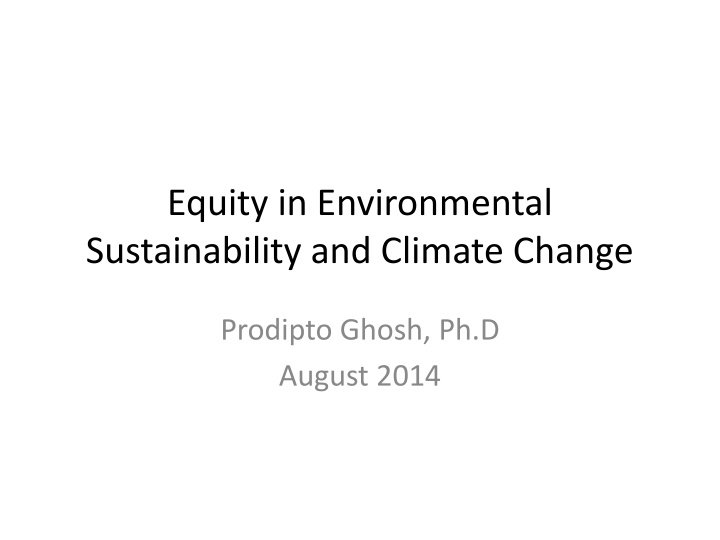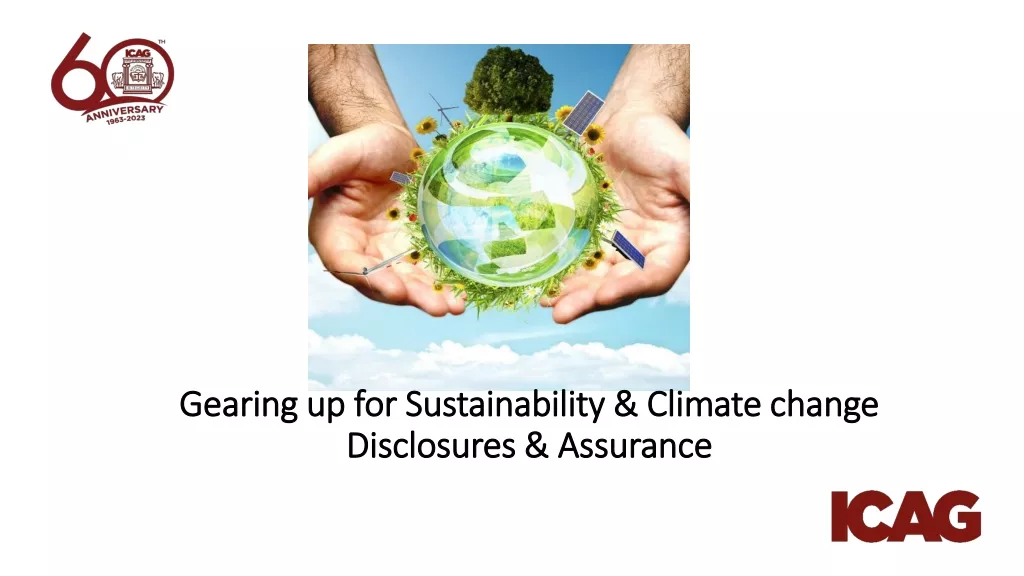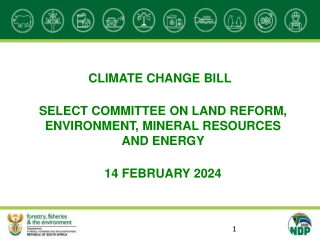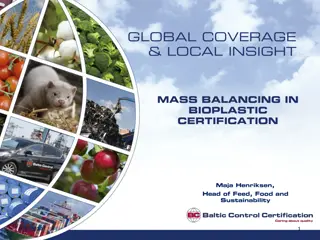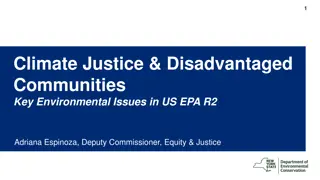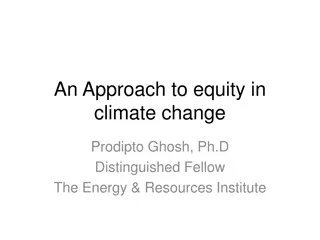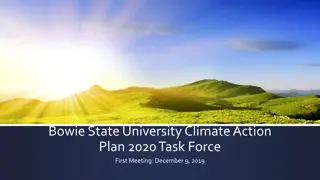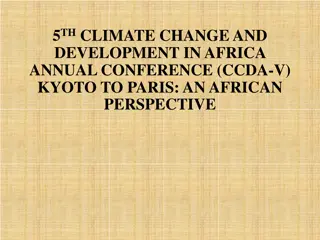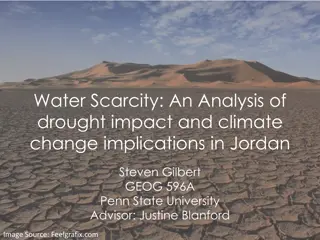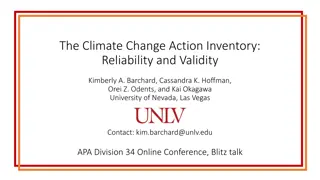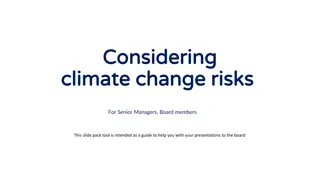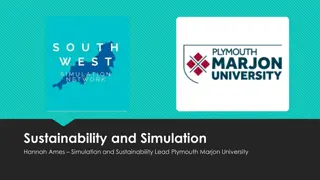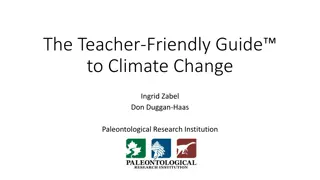Equity in Environmental Sustainability and Climate Change
This content discusses the importance of inter-generational equity, costs of GHG mitigation for India, and the impacts of sustainability and climate change on future generations. It highlights the concept of protection from harm and the rights of future generations to a safe environment.
Download Presentation

Please find below an Image/Link to download the presentation.
The content on the website is provided AS IS for your information and personal use only. It may not be sold, licensed, or shared on other websites without obtaining consent from the author.If you encounter any issues during the download, it is possible that the publisher has removed the file from their server.
You are allowed to download the files provided on this website for personal or commercial use, subject to the condition that they are used lawfully. All files are the property of their respective owners.
The content on the website is provided AS IS for your information and personal use only. It may not be sold, licensed, or shared on other websites without obtaining consent from the author.
E N D
Presentation Transcript
Equity in Environmental Sustainability and Climate Change Prodipto Ghosh, Ph.D August 2014
Coverage Inter-generational equity: Costs of GHG mitigation for India Social Discount Rates in the inter-generational context Historical responsibility for climate change Intra-generational equity: Contraction and convergence : Aubrey Meyer Presentation to UNFCCC on behalf of India Greenhouse Development Rights : Stockholm Environment Institute 2
Costs of GHG Mitigation for India Results of energy-economic modeling studies carried out by TERI and NCAER
Undiscounted Incremental Energy System Cost for CO2 reductions from Illustrative Scenario (2011-31) Undiscounted Incremental System Cost 1200 1000 800 Billion US$ 600 400 200 0 0% 5% 10% 15% 20% 25% 30% Progressive CO2 emission reduction from Illustrative scenario in year 2031(in %) 10% reduction: ~ US$ 240 Billion 20% reduction: ~ US$ 499 Billion 4 30% reduction: ~ US$ 1062 Billion
Loss of GDP in the Carbon Tax Scenario (2010- 11 to 2030-31) Scenarios $10 Carbon Tax $20 Carbon Tax $40 Carbon Tax $80 Carbon Tax 0 Loss of GDP -1000 -668 -1194 -2000 -2173 -3000 -4000 Undiscounted Cummulative GDP Loss -4013 -5000 US $ billion (constant 2005) REV +ve
Inter-generational Equity Source: Stern review 6
Inter-generational equity Impacts of sustainability/climate change on future generations and other nations raise very firmly questions of rights. Protection from harm done by others lies at the heart of many philosophical approaches to liberty, freedom and justice. Protection from harm is also expressed in many legal structures round the world in terms of legal responsibility for damage to the property or well- being of others. 7
Inter-generational equity Many would argue that future generations have the right to enjoy a world whose climate has not been transformed in a way that makes human life much more difficult. A concept related to the idea of the rights of future generations is that of sustainable development: future generations should have a right to a standard of living no lower than the current one. This principle need not imply that the whole natural environment and endowment of resources should be preserved by this generation for the next generation in a form exactly as received from the previous generation. 8
Inter-generational equity On the other hand, it seems quite clear that, at a basic level, the global environmental and ecological system, which provides us with life support functions such as stable and tolerable climatic conditions, cannot be substituted. In this approach each generation has the responsibility of stewardship. Some would see the climate in this way, since it shapes so much of all the natural environment and is not straightforwardly substitutable with other capital. 9
The Social Discount Rate The effects of GHGs emitted today will be felt for a very long time. That makes some form of evaluation or aggregation across generations unavoidable. The ethical decisions on, and approaches to, this issue have major consequences for the assessment of policy. Typically, in project and policy appraisal, an increment in future consumption is held to be worth less than an increment in present consumption, for two reasons. 10
Social Discount Rate Assessing impacts over a very long time period raises the problem that future generations are not represented in current decision-making. Stern s Approach: If a future generation will be present, we suppose that it has the same claim on our ethical attention as the current one. 11
Social Discount Rate Combining these considerations with the assumption of isoelastic (constant elasticity of utility wrt consumption) utility functions, Stern arrives at a very low inter-generational discount rate, which drives his conclusion that the present value of future climate change impacts is very high in relation to future GDP (upto 20% of GDP). Formal mathematical treatment of these concepts is given in The Stern Review, Part I, Technical Appendix. The Stern approach has been criticized by several scholars, in particular, Nordhaus, 2007. 12
Historical responsibility for climate change Source: Country presentations at the AWG-LCA Workshop, Bonn: June 2009: www.unfccc.int and TERI studies 13
Historical responsibility for climate change G 20 members (1850-2011) Source: TERI analysis based on World Bank PPP and population data and WRI-CAIT GHG emissions data
GHG Emissions per capita G 20 members Emissions per Capita (2011) of G20 Countries 20 18 16 14 12 MtCO2 per capita 10 8 6 4 2 0 Data source: Total CO2 Excluding Land-Use Change and Forestry (MtCO2), WRI, CAIT 2.0. 2014. Climate Analysis Indicators Tool: WRI s Climate Data Explorer. Washington, DC: World Resources Institute Population (Millions), World Bank, 2013, Measuring the Real Size of the World Economy: The Framework, Methodology, and Results of the International Comparison Program. Washington, DC: World Bank, Developed Countries Developing Countries Missing Data Source: TERI analysis based on World Bank PPP and population data and WRI-CAIT GHG emissions data
Emissions Intensity (2011) of G20 Countries 0.8 0.7 0.6 0.5 MtCO2 /billion US $ 0.4 0.3 0.2 0.1 0 Data source: Total CO2 Excluding Land-Use Change and Forestry (MtCO2), WRI, CAIT 2.0. 2014. Climate Analysis Indicators Tool: WRI s Climate Data Explorer. Washington, DC: World Resources Institute GDP on PPP (billion US $), World Bank, 2013, Measuring the Real Size of the World Economy: The Framework, Methodology, and Results of the International Comparison Program. Washington, DC: World Bank, Developed Countries Developing Countries Missing Data Source: TERI analysis based on World Bank PPP and population data and WRI-CAIT GHG emissions data
UNFCC Provisions UNFCCC affirms that the largest share of historical and current emissions are due to developed countries. It also lays down the fundamental principle underlying the global climate change regime: all countries are expected to contribute to protection of the global environment, on the basis of common but differentiated responsibility and respective capability The debate on equity in the climate change negotiations are essentially about an agreed detailing of the CBDR principle. 17
Source: Laila Gohar , UK Met Office, Hadley Centre: Presentation at the AWG-LCA workshop on Historical Responsibility, UNFCCC, Bonn, June 2009. 18
North-South divide on elements of calculation choices: Cumulative emissions or temperature change: North: Temperature change is what drives climate change, not emissions per-se. South: Scientific uncertainty of linkage between GHG concentrations and temperature change. Earlier emissions count for less than later emissions, and this distinction is inequitious. 19
Calculation choices Start date: North: Countries were innocent of knowledge that GHG emissions would cause climate change, till recently, and so they cannot be held to account for cumulative emissions prior to (say) 1990. South: Scientific knowledge of climate change was available in 19th century (Arrhenius). In any event prior knowledge of likely harm from an action, or intent to cause harm (mens-rea) is relevant in the arena of criminal liability, and we are not in that arena but in that of determination of historical responsibility. Civil liability laws typically consider the consequences of harmful actions and not the intent behind them. 20
Calculation choices Sectors and gases: North: Count gases and sectors depending upon reliability of data. South: This would leave out CO2 from deforestation for earlier periods (when major deforestation occurred in the North) but include it for later periods (when it is happening primarily in the South). This creates an ad-hoc asymmetry between North and South. 21
Example 1: Contributions by regions to temperature increase since 1890 Source: Laila Gohar , UK Met Office, Hadley Centre: Presentation at the AWG- LCA workshop on Historical Responsibility, UNFCCC, Bonn, June 2009 22
Example 2: Contributions by country for different start dates Source: Laila Gohar , UK Met Office, Hadley Centre: Presentation at the AWG-LCA workshop on Historical Responsibility, UNFCCC, Bonn, June 2009 23
Two Approaches: China Source: Presentation by China at the AWG-LCA workshop, Bonn, June 2009 24
China 25
China 26
Brazils Approach Source: Presentation by Brazil at the AWG-LCA workshop, Bonn, June 2009 27
Brazil 28
Brazil 29
Contraction and Convergence Source: Contraction and Convergence, Aubrey Meyer Aubrey Meyer s methodology is based on equal per-capita entitlements to carbon space. Since the world s atmosphere belongs equally to everyone if it belongs to anyone at all, the only basis on which such an agreement seems possible is that there must eventually at least be an equal allocation to everyone in the world. 31
Developing country critiques of Contraction and Convergence : Aubrey Meyer s formulation does not take historical responsibility into account the remaining carbon space is proposed to be divided, but responsibility for the accumulated emissions which have reduced the available carbon space is forgiven. This imposes an unfair burden on those countries which have had historically low emissions, but whose current emissions are relatively high (e.g. South Africa). 33
Sterns critique of equal per-capita: Source: Stern Review One is that the right of equal entitlements to the atmosphere for all humans, while it might seem natural to some, is essentially asserted. It is not clear why a common humanity in a shared world automatically implies that there are equal rights to emit GHGs. Equality of rights, for example to basic education and health, or to common treatment in voting, can be related to notions of capabilities, empowerment, or the ability to participate in a society. How does the right to emit stand in relation to these rights? Rights are of great importance in ethics but they should be argued rather than merely asserted. More pragmatically, action on climate change requires international agreement and this is not a proposition likely to gain the approval necessary for it to be widely adopted. 34
Developing country critique of Sterns critique of equal per capita It is not true that formal defence of equal per capita does not exist in the published literature, Stern s research has neglected such literature (e.g. Ghosh, 1993). Stern himself has simply asserted (not argued) welfare maximization as the appropriate ethical norm for inter- generational equity. An application of Stern s principles to intra-generational equity would result in in less than equal per-capita allocations to the North as compared to the South. Since we are in the space of assigning endowments of GHG emissions rights (in both inter- and intra-generational contexts), there is no valid reason for not treating inter- and intra-generational equity through identical principles. 35
Presentation on behalf of India to the UNFCCC (Prodipto Ghosh, June 2012)
The Terrain of Equity in Climate Change Securing the interest (and involvement of) future generations Obligations of Parties in relation to GHG mitigation, Obligations of Parties in relation to Adaptation to impacts of climate change Obligations of Parties wrt loss of livelihoods owing to GHG mitigation actions by others Obligations and entitlements of Parties wrt transfer of finances and technology Climate change obligations need to be realized on the basis of equity, if the arrangements are to have wide political acceptability, and hence sustainability in practice. 37
The imperative of formal justification of proposed equity principles In The Economics of Climate Change ,Nick Stern asserted that advocates of equity norms, must do more than simply assert the norm they must provide justification. We accept this prescription and subject our proposed equity norm to a test of validation paralleling the scientific method. The referenced paper provides the full discussion. 38
Proposed equity norm Proposition 1: All humans should cooperate in securing the Ultimate Objective in respect of the global climate (furnished in Art 2 of the UNFCCC), the terms of such cooperation being as follows: Proposition 2: In respect of persons of low capability, in order to remedy the residual damage of climate change impacts (i.e. when the Ultimate Objective is met), persons of high capability should provide resources and technology in proportion to their respective capabilities. Note: The residual damage may be within or external to a given country. The point is that the obligation of a country to remedy the damage depends only upon its respective capability. Thus, a poor country, with little capability, but high climate damage would be entitled to transfer of resources from others with high capability. 39
Equity norm Proposition 3: In respect of persons of low capability, in order to enable such persons to remain within their assigned entitlements to the global environmental resources while continuing to develop unfettered, persons of high capability should provide resources and technology in proportion to their respective capabilities. Proposition 4: In respect of harm to persons of low capability beyond residual damage i.e. when the Ultimate Objective is not met, persons who have exceeded their respective shares of the global environmental resource and have high capability must remedy such excess harm in proportion to the extent to which they have exceeded their respective entitlements. 40
Equity norm Proposition 5: In respect of those with low capability whose livelihoods are adversely affected by the actions of others to mitigate GHG emissions, assistance towards alternative livelihoods must be provided by those with high capability in proportion to their respective capabilities.. Proposition 6: All human beings have equal entitlements to global environmental resources. Each person is the legatee of her parents, and carries their undischarged obligations as well as their unused entitlements. They may exchange these entitlements/obligations by mutual, prior, informed consent. These entitlements/obligations, in the aggregate are limited by the Ultimate Objective of the Climate Change Convention. The context, of course, is global society comprised of sovereign states, in turn comprised of, and representing human beings. Thus the actual locus of the Propositions will be sovereign states, rather than individuals. 41
Methodology: Test of invalidation The methodology derives from Karl Popper s (1968) critical rationalist philosophy of science which holds that the growth of scientific knowledge occurs through deliberate attempts to falsify, rather than confirm, proposed hypotheses. A hypothesis proceeds to the status of a theory after surviving repeated tests of falsification. Details of the methodology are provided in referenced paper 42
Greenhouse Development Rights Source: Greenhouse Development Rights, Stockholm Environment Institute, 2008 An approach to intra-generational equity formulated by EcoEquity and the Stockholm Environmental Institute (SEI). Overall perspective: An emergency climate stabilization program is needed, that such a program is only possible if the international effort-sharing impasse is decisively broken, and that this impasse arises from a severe, but nevertheless surmountable, conflict between the climate crisis and the development crisis. Addresses the concern in the North that the rich in the South should also share the burden of GHG mitigation. 43
GDR: Emissions Pathways: The South s Dilemma. The red line shows the 2 C Emergency Pathway, in which global CO2 emissions peak in 2013 and fall to 80 percent below 1990 levels in 2050. The blue line shows Annex I emissions declining to 90 percent below 1990 levels in 2050. The green line shows, by subtraction, the emissions space that would remain for the developing countries. 44
GDR: Development Threshold Development Threshold: a level of welfare below which people are not expected to share the costs of the climate transition. Threshold set at $ 20 per day per capita consumption, i.e. 25% above $ 20 per day (or $ 7,500 per capita per year PPP) a level at which malnutrition, high infant mortality, low educational attainment, high relative food expenditures begin to disappear. Authors accept that setting the level of threshold could be debated. 45
Capacity: Income above the development threshold. These curves approximate income distributions within India, China, and the United States. Thus, the green areas represent national incomes above the ($20 per person per day, PPP) development threshold .Chart widths are scaled to population, so these capacity areas are correctly sized in relation to each other. Based on projected 2010 data. 46
Capability (capacity) and Responsibility Capability (capacity): A nation s aggregate capacity is defined as the sum of all individual incomes, excluding income below the threshold. Responsibility: is contribution to the climate problem, defined as cumulative emissions since 1990, excluding emissions that correspond to consumption below the development threshold. These measures of capacity and responsibility can then be combined into a single indicator of obligation, in a Responsibility Capacity Index (RCI). This calculation is done for all Parties to the UNFCCC, based on country-specific income, income distribution, and emissions data. Authors concede that the start date of 1990 could also be debated. 47
Critiques of GDR: Relies on internal income distributions of countries for determination of capability . This is difficult to justify as it penalizes more equitable societies at the cost of the less equitable (e.g. Japan vs US) Does not address historical responsibility Empirically problematic: internal distributions of income (esp. developing countries), purchasing power parity (not wholly objective) 48
References: The Economics of Climate Change: Stern Review, 2006, Government of the United Kingdom: http://www.webarchive.nationalarchives.gov.uk Country presentations at the AWG-LCA Workshop, Bonn: June 2009: http://www.unfccc.int Contraction and Convergence : Aubrey Meyer: Green Books, 2001: ISBN 13: 9781870098946 Greenhouse Development Rights : Stockholm Environment Institute, 2008: http://www.GreenHouseRights.org Equity in Climate Change A suggested approach : Prodipto Ghosh, Economic and Political Weekly, Vol. XLVIII, No. 12, March 2013 Other Readings: Comment on the Stern Review: William Nordhaus, May 2007 (pdf copy sent by email). Structuring the equity Issue in Climate Change: Prodipto Ghosh, in Climate Change, An Indian Perspective: Amrita Achanta (Ed), Tata Energy Research Institute, 1993. (Scan copy on request). 49
